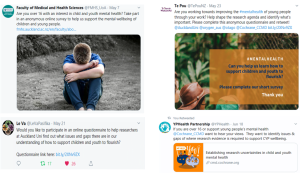In this blog for mental health researchers and those interested in evidence synthesis, Sarah Hetrick and Vartika Sharma, researchers at the Cochrane Common Mental Disorders – Children and Young People Satellite (hosted by the Department of Psychological Medicine, University of Auckland, New Zealand) look at the benefits and practicalities of engaging with young people in the process of undertaking child and youth mental health research. This blog is one of a series on Evidently Cochrane, #YoungMindsMatter.
The Cochrane Common Mental Disorders (CCMD), part of the international not-for-profit Cochrane organization, provides up-to-date and accurate evidence to support healthcare decision making for people with common mental disorders. Established under the aegis of CCMD, the Children and Young People Satellite in New Zealand, specifically focusses the mental health of children and young people. In our work, we (like other researchers) are inundated with research ideas – some from our own interest and others due to the expectations of different funding bodies. But we know that limited engagement of end users in developing research ideas, means that the research that is done might not address actual needs and so might not be used. So how do researchers pull themselves out of this quagmire and ensure that the scarce research dollar is well spent?
As a Satellite, we are keen to set this right by engaging with stakeholders, including young people themselves, in order to identify and prioritise research questions that would be the focus of the Satellite’s work over the next few years.
Different perspectives, different priorities
One of the first activities undertaken by the Satellite has been to co-design a priority list of questions about child and youth mental health that research should answer. Priorities can differ depending on who is involved – what is a priority for a clinician may not be a priority for a young person or their caregiver or a policy-maker. Therefore, it is important to reach out to a diverse group of people, each of whom will use a different lens to decide on priorities. The lens used might be related to feasibility – required time for implementation, available financial resources; or may be more personal factors such as individual experiences or those of their families and friends; or a broader objective of reducing inequity between different populationThe group of people being studied. Populations may be defined by any characteristics e.g. where they live, age group, certain diseases. groups due to ethnicity or religion, sexual and gender identify, geography, socio-economic class, or disability.
Global collaboration on research prioritisation
Partnerships with international collaborators can be an important step towards shaping a global research agenda while maintaining its local relevance. We have had the opportunity to work closely with like-minded organisations and influencers to reach out and engage with a huge variety of people to enhance international participation in determining the research priorities. Our institutional partners were spread across geographies and included, for example, Wisdom2action (Canada), Centre for Evidence and Implementation, Orygen and the University of Melbourne (Australia), the University of Oslo and the Campbell Collaboration (Norway) and University of York (England).
To ensure better understanding of research questions across a range of international participants, we simplified the survey tool by avoiding local terms – used the word ‘indigenous population groups’ instead of specific names such as Māori (indigenous population group in New Zealand) or Aboriginal and Torres Strait Islanders (in Australia), Sami (in Norway), or specific names of health services such as Child and Adolescent Mental Health Services (used in England and New Zealand), which may be referred to by a different name in other countries.
Seeking survey responses through social media
International participants were sought by creating an anonymous online survey and sharing the survey link using various social media networks. The core research team, along with their professional networks and partner institutes, regularly shared the survey link via their institutional and personal Twitter, Facebook and LinkedIn accounts. Customised images were designed to provide the visual appeal of the social media posts and improve response rateThe speed or frequency of occurrence of an event, usually expressed with respect to time. For instance, a mortality rate might be the number of deaths per year, per 100,000 people.. Over a two-month period, we received more than 285 responses, approximately 40% from those who lived outside New Zealand. It was encouraging to note that 35% of our respondents were young people (16-29 years). While using an online survey is a resource-efficient way to improve research participation, incomplete survey responses can be a key challenge, and might be addressed by thinking about the actual design and content of the survey questions.

Young people shaping the research agenda
To ensure end-to-end consumer‘Consumer’ is Cochrane’s preferred term for patients (or someone with personal experience of a health condition), care-givers or family members of someone with a health condition. (https://consumers.cochrane.org) engagement (young people) in the systematic review process, we are conducting focus group discussions with young people in New Zealand and the UK to co-design review outcomesOutcomes are measures of health (for example quality of life, pain, blood sugar levels) that can be used to assess the effectiveness and safety of a treatment or other intervention (for example a drug, surgery, or exercise). In research, the outcomes considered most important are ‘primary outcomes’ and those considered less important are ‘secondary outcomes’. for an upcoming Cochrane ReviewCochrane Reviews are systematic reviews. In systematic reviews we search for and summarize studies that answer a specific research question (e.g. is paracetamol effective and safe for treating back pain?). The studies are identified, assessed, and summarized by using a systematic and predefined approach. They inform recommendations for healthcare and research. on self-harm and suicide prevention interventions in education settings. It has been interesting to see how young people have emphasised the importance of outcomes related to self-care and self-esteem and their reflection on mental wellbeing via both positive (e.g. seen as confident, happy) and negative behaviors (e.g. substance use, self-harm). These outcomes are, in the main, quite different from those that would be typically reported in randomizedRandomization is the process of randomly dividing into groups the people taking part in a trial. One group (the intervention group) will be given the intervention being tested (for example a drug, surgery, or exercise) and compared with a group which does not receive the intervention (the control group). control trialsClinical trials are research studies involving people who use healthcare services. They often compare a new or different treatment with the best treatment currently available. This is to test whether the new or different treatment is safe, effective and any better than what is currently used. No matter how promising a new treatment may appear during tests in a laboratory, it must go through clinical trials before its benefits and risks can really be known. about interventions for self-harm or suicide prevention and thus highlight the importance of engaging with young people to shape the research agenda that is relevant to them.
Navigating some of the challenges
Engaging with young people can be both exciting and challenging – exciting as it brings fresh perspectives, ‘expert’ advice from their lived experiences and most importantly an opportunity to understand what they need rather than what we think they need (actual vs. perceived needs).
Confidentiality and safeguards
The challenges range from finding engaging and youth-friendly ways of working with young people in what could be “dry” discussions, to finding safe spaces and working around their limited availability. Further, researchers often have to do a fine-balancing act of navigating through several layers of gatekeepers to involve young people and ensuring that participation remains completely voluntary, and that the information provided during the discussions remains completely confidential. The latter can be particularly challenging in groups with participants who are well-acquainted with each other and thus may inadvertently create peer-pressure to be socially compliant in their responses.
This problem may also arise when young people are accompanied by support people, who are often essential to have in the room because of cultural protocols and safetyRefers to serious adverse effects, such as those that threaten life, require or prolong hospitalization, result in permanent disability, or cause birth defects. procedures. While this may be true for any participantA person who takes part in a trial, often but not necessarily a patient. group, it becomes particularly relevant for young people who might be more influenced by the need to be accepted by the peer group than adults. Therefore, maintenance of confidentiality and privacy within the group should be one of the key ground rules for group discussions organised with young people. Co-designing these ground rules can be a great way to begin discussions. Further, having necessary safeguards (e.g. immediate access to a clinician) to address any mental distress due to participation in research activities is highly recommended.
Ensuring mutual benefit
It is important to ensure that engagement with young people is mutually beneficial –researchers should invest sufficient time to gauge what it is that young people expect to gain from being involved in these sorts of activities. Researchers should ensure that they understand the expectations of young people in terms of their engagement and make all efforts to make their contribution meaningful for them.
While research methods are often meant to be sacrosanct, when engaging with young people it is important to remain flexible and provide necessary support to participants to enable their participation. Every effort should be made to adopt an inclusive approach for collaborating with young people, such as culturally appropriate practices (our groups included saying a short prayer before and at the end of each meeting), supporting travel costs for young participants, including from remote locations, allowing paper-based dataData is the information collected through research. collection so potential respondents who may have limited internet access can also participate, and offering adequate reimbursement for their time (for instance, we offer young people who attend our youth meetings/workshops, vouchers – worth approximately NZD 30/hour – for spending at a shopping centre chain that has several outlets and is thus easily accessible).
What happens next?
The Satellite envisages that systematic reviewsIn systematic reviews we search for and summarize studies that answer a specific research question (e.g. is paracetamol effective and safe for treating back pain?). The studies are identified, assessed, and summarized by using a systematic and predefined approach. They inform recommendations for healthcare and research. focused on research topics identified as a high priority by young people and other key stakeholders will go beyond examining the efficacyThe extent to which an intervention (for example a drug, surgery, or exercise), produces a beneficial result under ideal conditions. of clinical interventions and incorporate a broader remit. Such questions are likely to be related to the experiences of young people who have received target interventions, barriers and facilitators to implementation of these interventions in certain settings, and more importantly understanding the feasibility, relevance and effectivenessThe ability of an intervention (for example a drug, surgery, or exercise) to produce a desired effect, such as reduce symptoms. of interventions in the context of ethnically, culturally and sexually diverse population groups of young people. The outcome will be priorities that represent ‘potential investment areas’ and will drive a research agenda for children and young people’s mental health in New Zealand and internationally, for the Satellite and beyond.
Please complete our survey to prioritise evidence gaps
One of our current priority setting activities is a survey to prioritise evidence gaps for children and young people’s mental health, and we are eager for those who engage with this blog series to fill in the survey and encourage all their followers and networks to engage in it. Complete the survey.
Take-home points
- ‘Nothing for us without us’ is not a phrase we created but definitely a phrase we commit to operate by.
- The involvement of children and young people is critical for doing research that is meaningful and relevant in improving their mental health and wellbeing.
- Being inclusive, culturally appropriate and adopting youth-friendly ways of engaging young people is critical.
- International partnerships should be considered to find universal solutions, adaptable to local context, for addressing mental health challenges.
Join in the conversation on Twitter with @Vartika_Sharmaa @SarahShetrick @Cochrane_CCMD @CochraneUK #YoungMindsMatter or leave a comment on the blog. Please note, we will not publish comments that link to commercial sites or appear to endorse commercial products.
About the bloggers:
Sarah Hetrick is the joint co-ordinating editor of the Cochrane Common Mental Disorders Group (CCMD) and responsible for the Child and Young People satellite of this group. Vartika Sharma’s biography appears below.
Declaration of interest:
Vartika Sharma reports grants from Royal Society of New Zealand and grants from Faculty Research Development Fund-Faculty of Medical and Health Sciences, University of Auckland, during the conduct of the work.
Sarah Hetrick reports grants from Royal Society of New Zealand, grants from Faculty Research Development Fund-Faculty of Medical and Health Sciences, University of Auckland, during the conduct of the work; grants from Auckland Medical Research Foundation Douglas Goodfellow Repatriation Fellowship, outside the submitted work; and I am the joint co-ordinating editor of the Cochrane Common Mental Disorders Group and take responsibility for the Child and Young Person Satellite.



I thoroughly enjoyed reading your blog post. It’s fantastic to see the emphasis you place on involving patients and the public in setting research agendas. Engaging them not only leads to more relevant and impactful studies but also fosters a sense of ownership and collaboration. Kudos to you for highlighting the importance of diverse perspectives and addressing uncertainties in research.